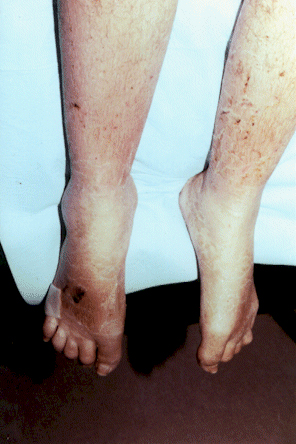Resumo
Definição
História e exame físico
Principais fatores diagnósticos
- presença de fatores de risco
- dor crônica
- dor do membro com radiação
- alodinia e hiperalgesia
- alterações no esquema corporal
- edema
- alterações tróficas na pele e na unha
- eritema ou aparência azulada
- alterações locais ou assimetria na sudorese
- fraqueza muscular
Outros fatores diagnósticos
- tremores
- postura distônica
- contraturas
- perda sensorial em distribuição em luva ou meia
- alterações locais no crescimento capilar
- bolhas na pele
Fatores de risco
- trauma
- imobilização
- sexo feminino
Investigações diagnósticas
Primeiras investigações a serem solicitadas
- nenhum exame é necessário: o diagnóstico é clínico.
Investigações a serem consideradas
- eletromiografia
- estudos da condução nervosa com eletrodos de superfície
- biópsia por punção cutânea
- radiografia do membro afetado
- cintilografia óssea com tecnécio-99m
- absorciometria por dupla emissão de raios X (DEXA)
- TC quantitativa
- RNM
- estudos vasculares
- bloqueios do nervo simpático
- bloqueios anestésicos seletivos ou regionais intravenosos
Novos exames
- teste autonômico
Algoritmo de tratamento
síndrome da dor regional complexa (CRPS) precoce (dentro de 6 meses a partir do início)
síndrome da dor regional complexa (CRPS) crônica (>6 meses desde o início)
Colaboradores
Autores
Anuj Aggarwal, MD
Clinical Assistant Professor
Anesthesiology, perioperative and pain medicine
Stanford University
Redwood City
CA
Declarações
AA declares that he has no competing interests.
Agradecimentos
Dr Anuj Aggarwal would like to gratefully acknowledge Dr Nicholas Shenker, Dr Gaurav Chhabra, and Dr Steven H. Horowitz, previous contributors to this topic.
Declarações
NS is medical adviser to Cambridge Nutraceuticals with stock options. He has received consultancy fees from Roche to provide unrestricted sponsored educational meetings, and grants from Versus Arthritis, the National Institute for Health Research Clinical Research Network, and the Medical Research Council. NS is an author of references cited in this topic. GC has been sponsored by Medtronic, Boston Scientific, Abbott, Nevro, Stimwave, and Polar Medical for attending various conferences and cadaveric workshops relevant to pain medicine and neuromodulation. GC is an associate examiner for the European Society of Regional Anaesthesia & Pain Therapy European Diploma of Pain Medicine exam and is also the regional advisor for pain medicine for the South West Severn deanery. SHH declares that he has no competing interests.
Revisores
Andre Tomasino, MD
Department of Neurological Surgery
Weill Cornell Medical College
New York-Presbyterian Hospital
New York
NY
Declarações
AT declares that he has no competing interests.
Ari Weinreb, MD, PhD
Associate Chief of Rheumatology
VA Greater Los Angeles Healthcare System
Associate Professor of Medicine
David Geffen School of Medicine
UCLA
Los Angeles
CA
Declarações
AW declares that he has no competing interests.
Jonathan Berman, MBBS
Consultant in Pain Management and Anaesthesia
Pain Management Department
Royal National Orthopaedic Hospital NHS Trust
Middlesex
UK
Declarações
JB has been reimbursed by Pfizer for lectures given at Pfizer-sponsored meetings and courses.
Créditos aos pareceristas
Os tópicos do BMJ Best Practice são constantemente atualizados, seguindo os desenvolvimentos das evidências e das diretrizes. Os pareceristas aqui listados revisaram o conteúdo pelo menos uma vez durante a história do tópico.
Declarações
As afiliações e declarações dos pareceristas referem--se ao momento da revisão.
Referências
Principais artigos
Merskey H, Bogduk N, eds. Classification of chronic pain: descriptions of chronic pain syndromes and definitions of pain terms. 2nd ed. Task force on Taxonomy of the International Association for the Study of Pain. Seattle, WA: IASP Press; 1994:39-43.
Goebel A, Birklein F, Brunner F, et al. The Valencia consensus-based adaptation of the IASP complex regional pain syndrome diagnostic criteria. Pain. 2021 Sep 1;162(9):2346-8.Texto completo Resumo
Goebel A, Barker C, Birklein F, et al. Standards for the diagnosis and management of complex regional pain syndrome: results of a European Pain Federation task force. Eur J Pain. 2019 Apr;23(4):641-51.Texto completo Resumo
Harden RN, McCabe CS, Goebel A, et al. Complex regional pain syndrome: practical diagnostic and treatment guidelines, 5th Edition. Pain Med. 2022 Jun 10;23(suppl 1):S1-53.Texto completo Resumo
Cruccu G, Aziz TZ, Garcia-Larrea L, et al. European Federation of Neurological Societies (EFNS) guidelines on neurostimulation therapy for neuropathic pain. Eur J Neurol. 2007 Sep;14(9):952-70.Texto completo Resumo
Artigos de referência
Uma lista completa das fontes referenciadas neste tópico está disponível para os usuários com acesso total ao BMJ Best Practice.

Diagnósticos diferenciais
- Infecção
- Comprometimento arterial
- Patologia óssea
Mais Diagnósticos diferenciaisDiretrizes
- Complex regional pain syndrome: practical diagnostic and treatment guidelines, 5th edition
- Neuropathic pain in adults: pharmacological management in non-specialist settings
Mais DiretrizesConectar-se ou assinar para acessar todo o BMJ Best Practice
O uso deste conteúdo está sujeito ao nosso aviso legal